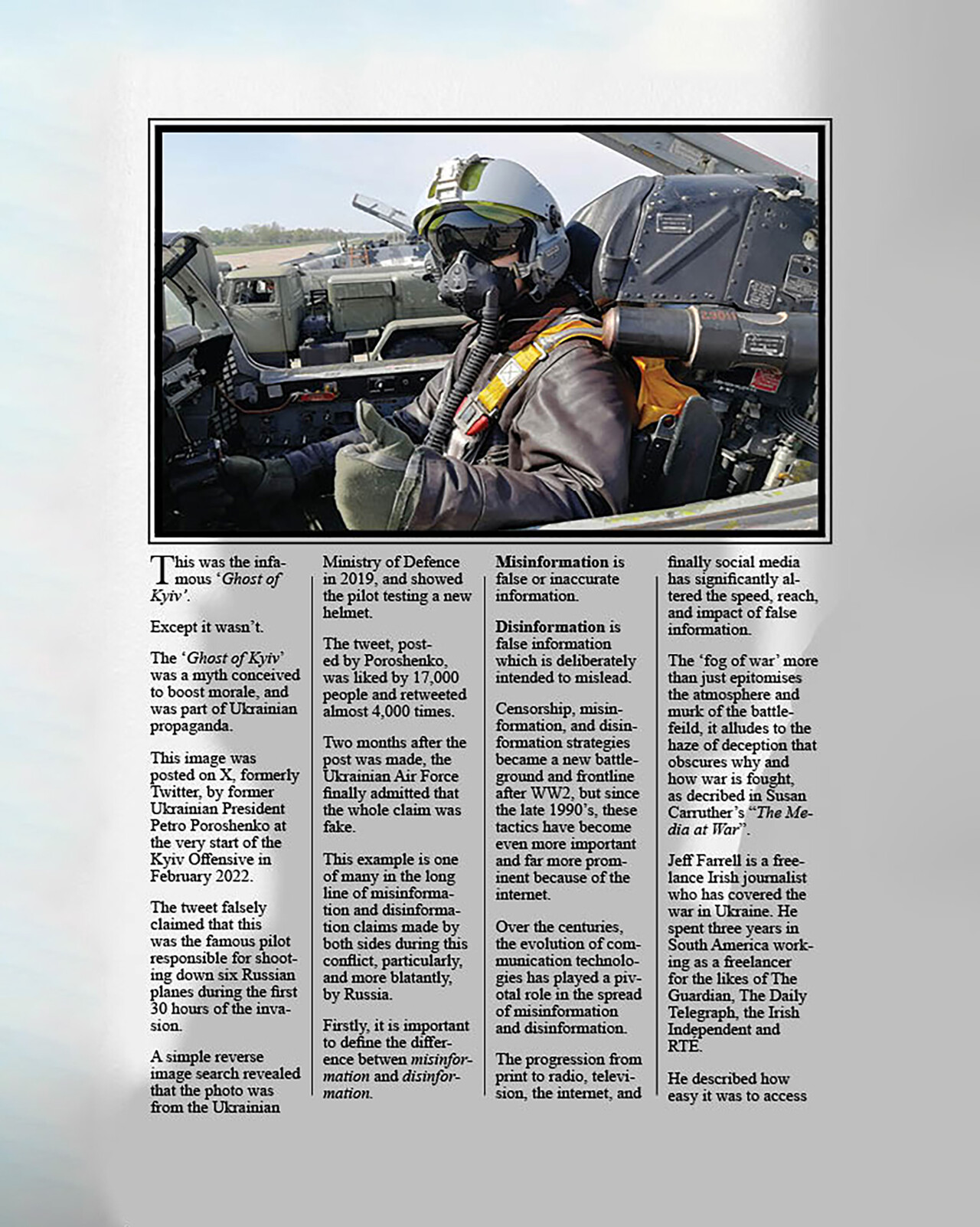




Elio is a keen and aspiring visual storyteller from Cashel, Co.Tipperary who loves to connect audiences with the piece through fascinating and captivating perspectives, be it visually or written. He was the Photo Editor of the award-winning magazine ‘Currently’ which won Magazine of the Year at SMEDIAs 2024. He aspires to specialise in the subject of war and conflict, and given the current situations in Gaza, Ukraine and the impending geopolitical threats across the globe, he feels that journalism is at a critical juncture between the crosshairs of what is or isn’t the truth and wants to be at the heart of this critical period for journalism.





The "Ghost of Kyiv" myth, a concoction intended to boost morale during the Kyiv Offensive in February 2022, is emblematic of the prevalence of misinformation and disinformation in modern conflicts.
Misinformation, referring to inaccuracies, and disinformation, the deliberate spread of falsehoods, have become pervasive, particularly in the digital age where social media serves as a potent tool for dissemination.
Journalists, like Jeff Farrell, initially had relatively unrestricted access to information in Ukraine but encountered heightened restrictions as the conflict escalated. Ukrainian authorities limited media access to prevent leakage of sensitive information to Russia, a move that some critics, such as Farrel himself, viewed as “a form of misinformation”, stifling transparency and accountability.
Conversely, on the Russian side, misinformation is deeply ingrained, making it challenging to ascertain accurate casualty figures. This dearth of reliable information poses a significant challenge for journalists striving to report on conflicts accurately and impartially.
Jeffrey Dvorkin highlights the exacerbating role of social media in spreading misinformation, “leading to moral panic and unreliable reporting”. He said that traditional media's reliance on sensationalism further compounds this issue, as financial pressures often prioritize accessible content over in-depth investigative reporting.
The Israel-Hamas conflict serves as a poignant example of how false claims, such as reports of beheaded babies, can rapidly proliferate through various media channels before being debunked. The decline in the embedding of journalists within military units, once commonplace, is attributed to organizational changes and managerialism within media organizations.
Eric Walravens underscores the overwhelming influx of information on the internet, making it increasingly challenging to discern truth from falsehood. This "noise" provides fertile ground for disinformation campaigns, as demonstrated by Russia's tactics during conflicts.
“The way you obliterate the truth is to make more noise, not censor it, because you cannot find your way through the amount of information that is there,” he said.
Tom Cheshire echoes concerns about information overload but suggests that this problem presents “an opportunity for journalists to prioritize credibility through rigorous investigative reporting.” This shift may redefine the role of journalism in the digital age, emphasizing the importance of fact-checking and accountability.
Ultimately, the widespread dissemination of misinformation threatens democracy and global stability, emphasizing the crucial role of investigative journalism in combating falsehoods and holding those in power accountable.
In conclusion, the "Ghost of Kyiv" myth and its subsequent debunking exemplify the complex landscape of modern warfare, where misinformation and disinformation play pivotal roles. While social media amplifies the spread of falsehoods, journalists face increasing challenges in navigating the murky waters of information warfare. However, amidst these challenges lies an opportunity for journalism to reaffirm its commitment to truth and integrity, ultimately safeguarding the pillars of democracy in an age of digital disruption.